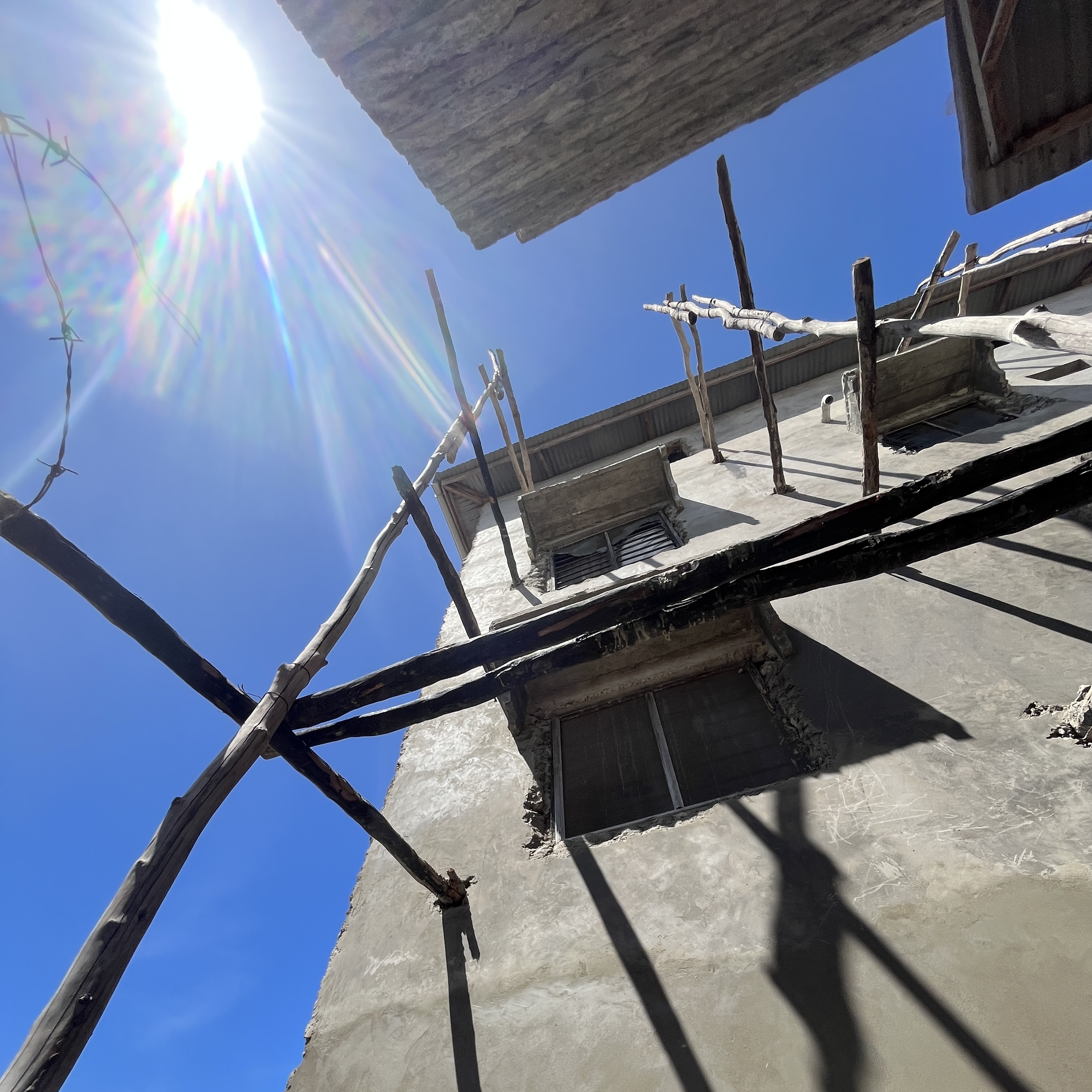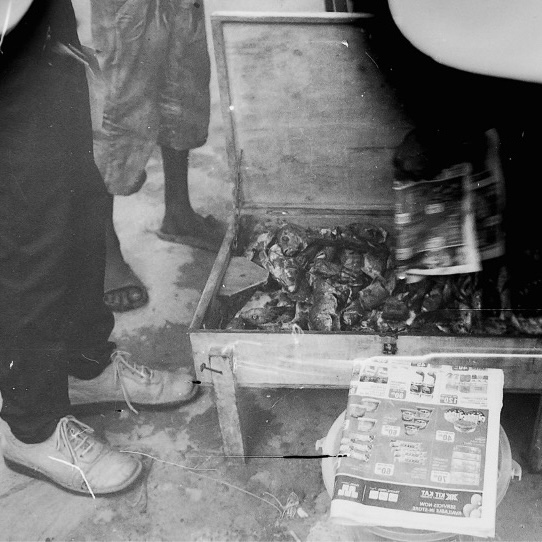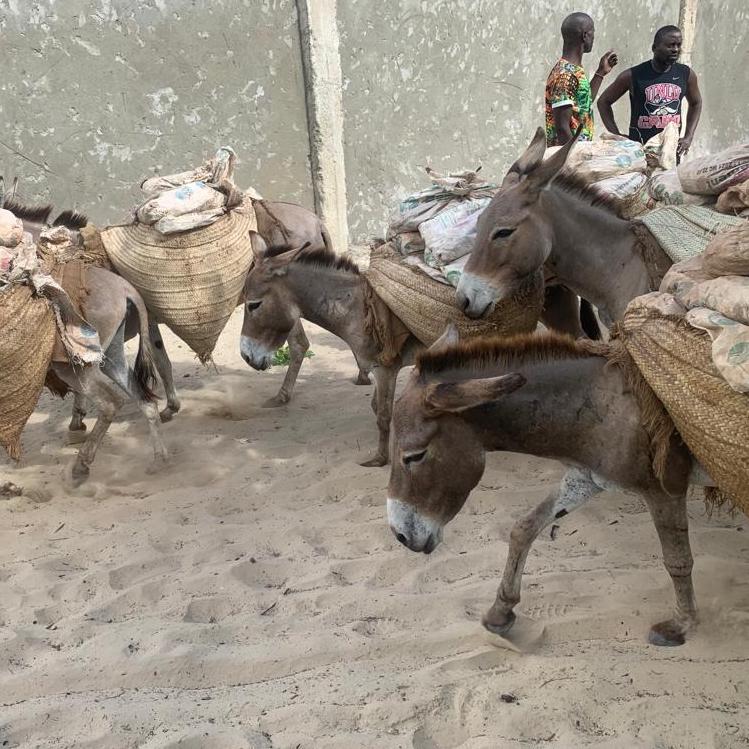Women, Migration and Everyday in Wiyoni
How do (migrant) women in Wiyoni construct a sense of belonging and sustain their everyday lives? How are these actions further related to the social and physical dimensions of infrastructure?
Authors:
Svenja Jakob
Tefle Mohammed
Rebecca Rodrigues
Lilian Salama
Natalia Krikotina
Wiyoni is a new and rapidly growing settlement in Lamu, home to a diverse population of both long-time Lamu residents and newcomers. This theme addresses the broad meaning of infrastructure in the context of Wiyoni, with a particular focus on the combination of its physical and social dimension. One notable example is the planned road connecting Wiyoni to other parts of the island and the support networks that emerge within the community in response to its construction.
![]()
S. in front of her shop
Many women in Wiyoni have migrated from other parts of Lamu County or the Kenyan coast in search of better economic opportunities for their families. However, migration often presents challenges, such as finding affordable housing, building new social connections, and overcoming the stigma of being an outsider. Despite these challenges, women remain prominent figures in Wiyoni's daily economy. They run small businesses selling juices, mahamri, ice cream, ice, and baobab snacks, and they also run cafes, beauty salons, and shops, catering to both their own needs and those of the community.
![]()
M. and family preparing baobab snacks
Svenja Jakob
Tefle Mohammed
Rebecca Rodrigues
Lilian Salama
Natalia Krikotina
Wiyoni is a new and rapidly growing settlement in Lamu, home to a diverse population of both long-time Lamu residents and newcomers. This theme addresses the broad meaning of infrastructure in the context of Wiyoni, with a particular focus on the combination of its physical and social dimension. One notable example is the planned road connecting Wiyoni to other parts of the island and the support networks that emerge within the community in response to its construction.
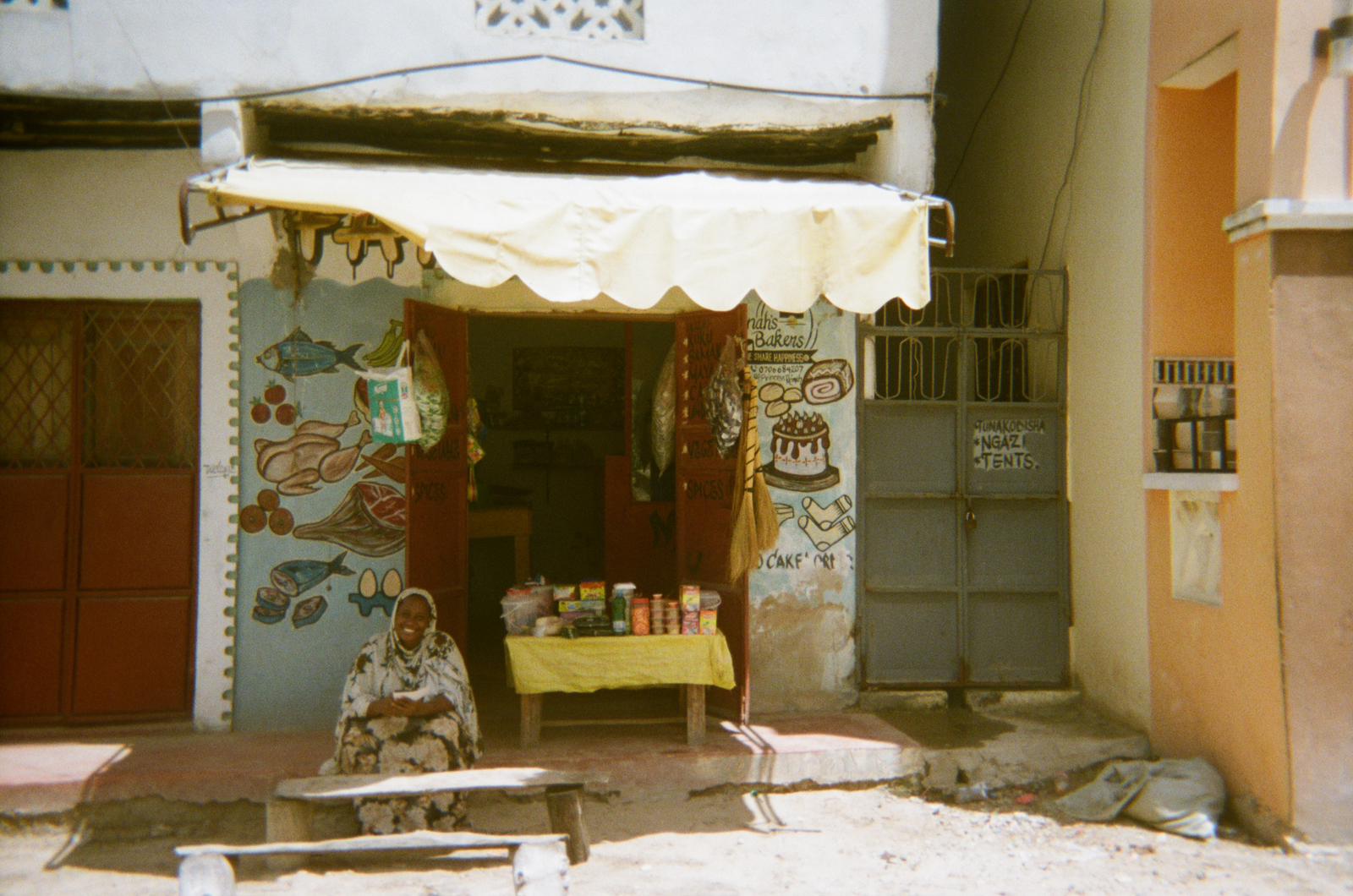
S. in front of her shop
Many women in Wiyoni have migrated from other parts of Lamu County or the Kenyan coast in search of better economic opportunities for their families. However, migration often presents challenges, such as finding affordable housing, building new social connections, and overcoming the stigma of being an outsider. Despite these challenges, women remain prominent figures in Wiyoni's daily economy. They run small businesses selling juices, mahamri, ice cream, ice, and baobab snacks, and they also run cafes, beauty salons, and shops, catering to both their own needs and those of the community.

M. and family preparing baobab snacks
To understand the forces that shape life and business in Wiyoni, the research team interviewed local residents, including shop owners, community leaders, newcomers, as well as officials from the municipality. The findings highlight the challenges of accessing education, finance, infrastructure, social connections, and security, and reveal how women navigate these challenges to sustain their lives and livelihoods.
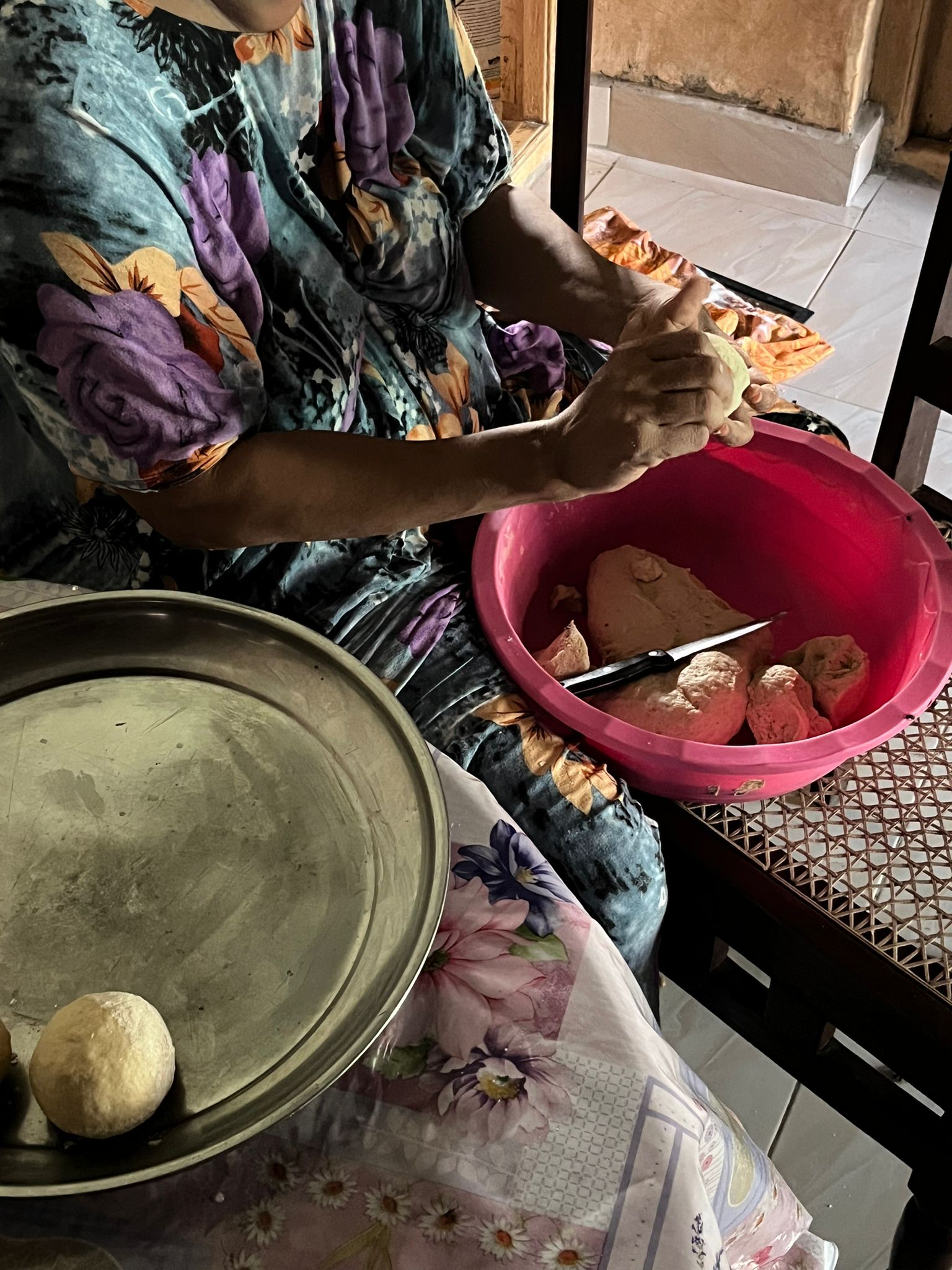
H. making mahamri at home during an informal interview
Projects
Women, Migration and Everyday in Wiyoni #2502
Understanding women’s business problems in Wiyoni
Before going to Lamu, my own thoughts about how Islamic society is organised and the potential challenges for local women to develop businesses freely would flash through my mind like subliminal frames. Having had experience interacting with Muslim communities before, I understood the differences in our views and wasn’t sure I would be able to feel free there, both as a woman and as a white tourist/researcher. From the first days, immersing myself in the details of local life thanks to living with host families, the traditions and rules of relationships between men and women became clearer and clearer.
![]()
Understanding the local relationship system, I relaxed a little and sank into just “being,” trying to stay more in the here and now rather than in my thoughts.
Having spent the first week studying Lamu for myself, we then moved on to interviews with local residents. We asked about infrastructural problems but we were met with indifference to this topic from local people. We returned to exploring other dynamics affecting Lamu Island and the Wiyoni area in particular. We walked along sandy roads washed out by the rain, talking to local women about life in Wiyoni. Most of them had moved here from other places; some were Muslim, others Christian. Trying to build their new lives here, these women face the fact that their families lack basic means to survive. They try to earn money to feed their children and give them an education that they themselves never had. After talking to a dozen women and looking around, we saw what we hadn’t noticed before – women sitting in front of their homes selling food, working, or running their small shops. But why had we not seen what had been shining right into our eyes this whole time, like a sunbeam reflected off a piece of glass?
![]()

Understanding the local relationship system, I relaxed a little and sank into just “being,” trying to stay more in the here and now rather than in my thoughts.
Having spent the first week studying Lamu for myself, we then moved on to interviews with local residents. We asked about infrastructural problems but we were met with indifference to this topic from local people. We returned to exploring other dynamics affecting Lamu Island and the Wiyoni area in particular. We walked along sandy roads washed out by the rain, talking to local women about life in Wiyoni. Most of them had moved here from other places; some were Muslim, others Christian. Trying to build their new lives here, these women face the fact that their families lack basic means to survive. They try to earn money to feed their children and give them an education that they themselves never had. After talking to a dozen women and looking around, we saw what we hadn’t noticed before – women sitting in front of their homes selling food, working, or running their small shops. But why had we not seen what had been shining right into our eyes this whole time, like a sunbeam reflected off a piece of glass?

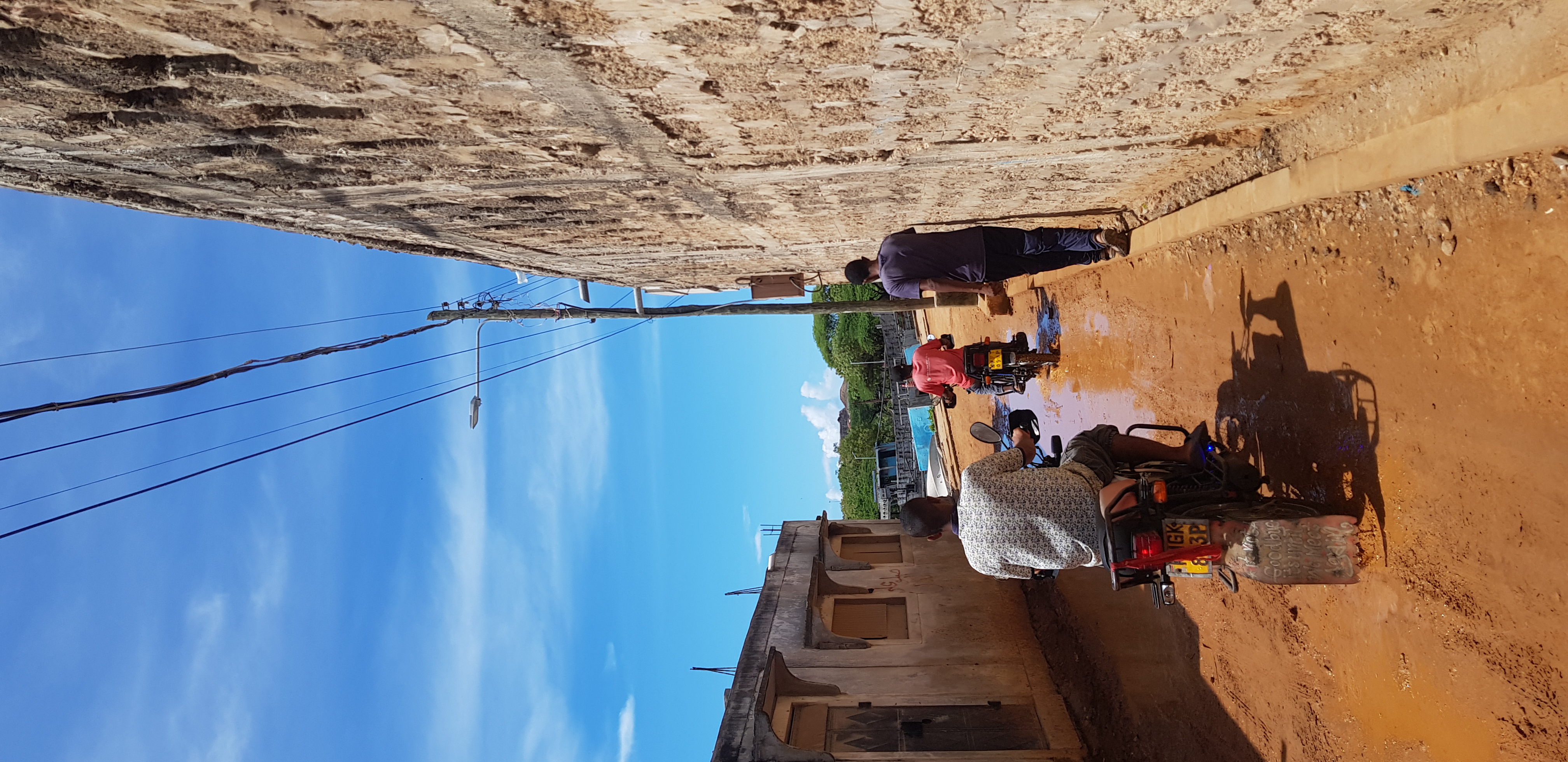
In Islamic society, a woman’s traditional role has been to care for the home and raise the children. Women still spend most of their time at home and when they run a business, it is often located at home or nearby. Women are “hidden” from strangers’ eyes, yet are an important part of Wiyoni’s social infrastructure.
The Covid-19 pandemic, which led to many divorces and a change in views on traditional family structure and household duties, challenged women to become more independent.
Analysing the knowledge we gained after several weeks of research, it became clear that women’s difficulties in Wiyoni are linked not only to Islam’s definitions of a woman’s place as interpreted in Lamu, but also to broader social changes. A lack of formal education, distrust in the state system, and, as a result, missed opportunities to seek support from organisations helping women’s businesses work together to create unique barriers for women-owned businesses.

While researching and trying to understand Wiyoni’s uniqueness in terms of women-owned businesses, I began wondering: is this case really unique in a global context? Studying works on Black feminism and feminism in general makes it clear that discrimination against women because of their gender, skin color, race, and social class is a pattern repeated on many pages of history. The struggles of building a business as not only a woman but also a newcomer to a community are deeply permeated with centuries of fighting for rights, facing discrimination, and striving for a brighter future. Yet, facing these challenges again and again, women coming with their families to live in Wiyoni continue their path, no matter what.
Women, Migration and Everyday in Wiyoni #2503
Kupatikana si Kukubalika:
Kupatikana si Kukubalika:
Belonging, Informality, and Moral Navigation Among Migrant Women in Wiyoni, Lamu
During a walk to Wiyoni, I noticed that one of the local people I had interacted with before was wearing her veil differently; in addition to her usual hijab, she was also wearing a niqab. Curious, I asked why. The answer came with gentleness, care, and a certain discomfort: she didn’t want to be recognized or associated with Wiyoni.
At first, I didn’t fully understand why. But as we talked more about it, I began to grasp (even if not explicitly) an unease in her words: a discomfort with how people from Wiyoni were perceived.
At first, I didn’t fully understand why. But as we talked more about it, I began to grasp (even if not explicitly) an unease in her words: a discomfort with how people from Wiyoni were perceived.
She described them as “modern,” influenced by outside customs, with different behaviors; almost as a threat, a stain on the expected moral conduct, or something that endangered tradition.
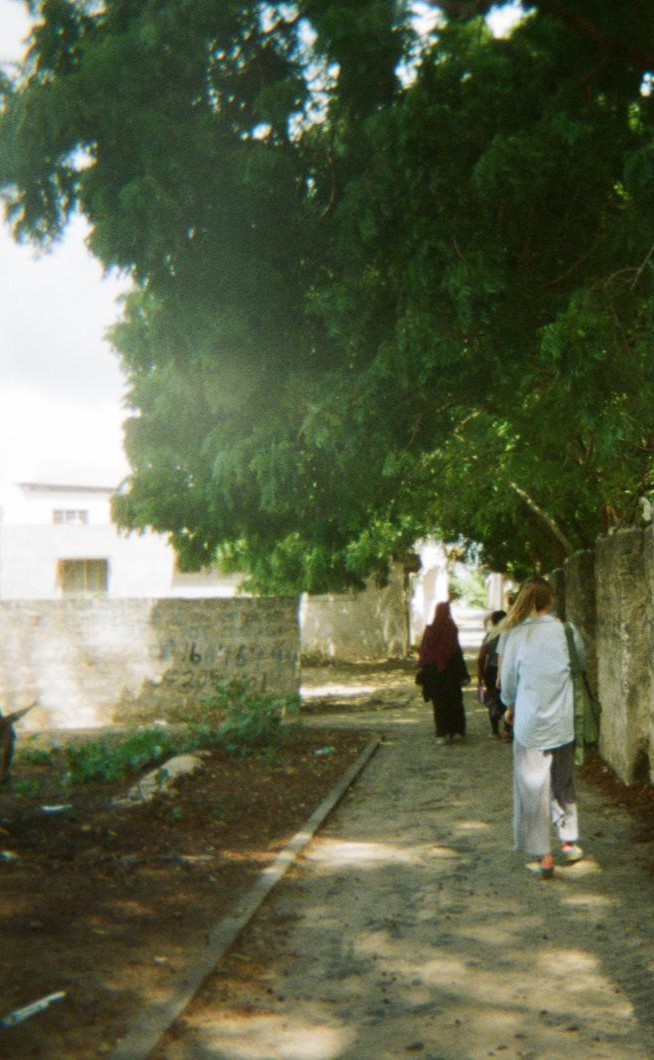
Research team during fieldwork in Wiyoni
Being associated with that neighborhood, or with the people who lived or circulated there, was a risk to her reputation within her own community. And in Lamu, community is one of the most valuable things a person can have. Beyond one’s immediate family, the community includes religious leaders, childhood friends, and neighbors — people you're taught from a young age to respect and keep close. It represents an extended network of financial, emotional, social, familial, and religious support; fundamental for belonging and success on the island: whether to get a job, to receive help in times of need, to secure housing, or to form a family.
In some way, this discomfort with the “new” or the “different” also echoed within the internal dynamics of this year’s research group, composed of researchers from UniBasel and LYA. During the last week, some local researchers shared their impressions, and it became clear that maintaining a relationship with us, foreign researchers, felt like walking a fine line. They enjoyed the company and accessed spaces they normally wouldn’t frequent, such as cafés, restaurants, interviewees’ homes, hotels, and more. Yet, at the same time, they felt a certain tension about what their families and the community might think. As different and external, we could represent a risk of moral influence. A possible departure from local norms and traditions.
In some way, this discomfort with the “new” or the “different” also echoed within the internal dynamics of this year’s research group, composed of researchers from UniBasel and LYA. During the last week, some local researchers shared their impressions, and it became clear that maintaining a relationship with us, foreign researchers, felt like walking a fine line. They enjoyed the company and accessed spaces they normally wouldn’t frequent, such as cafés, restaurants, interviewees’ homes, hotels, and more. Yet, at the same time, they felt a certain tension about what their families and the community might think. As different and external, we could represent a risk of moral influence. A possible departure from local norms and traditions.
It was in this friction, between visibility, belonging, and exclusion, that I began to perceive a deeper tension in Lamu, within the community and, beyond it, among its residents. Belonging in the local community was not a given, not even for those born there or connected through friendship or faith. There were subtle limits and unofficial but widely understood rules that determined who could occupy certain spaces, under what conditions, and when it was acceptable to slightly cross the line.
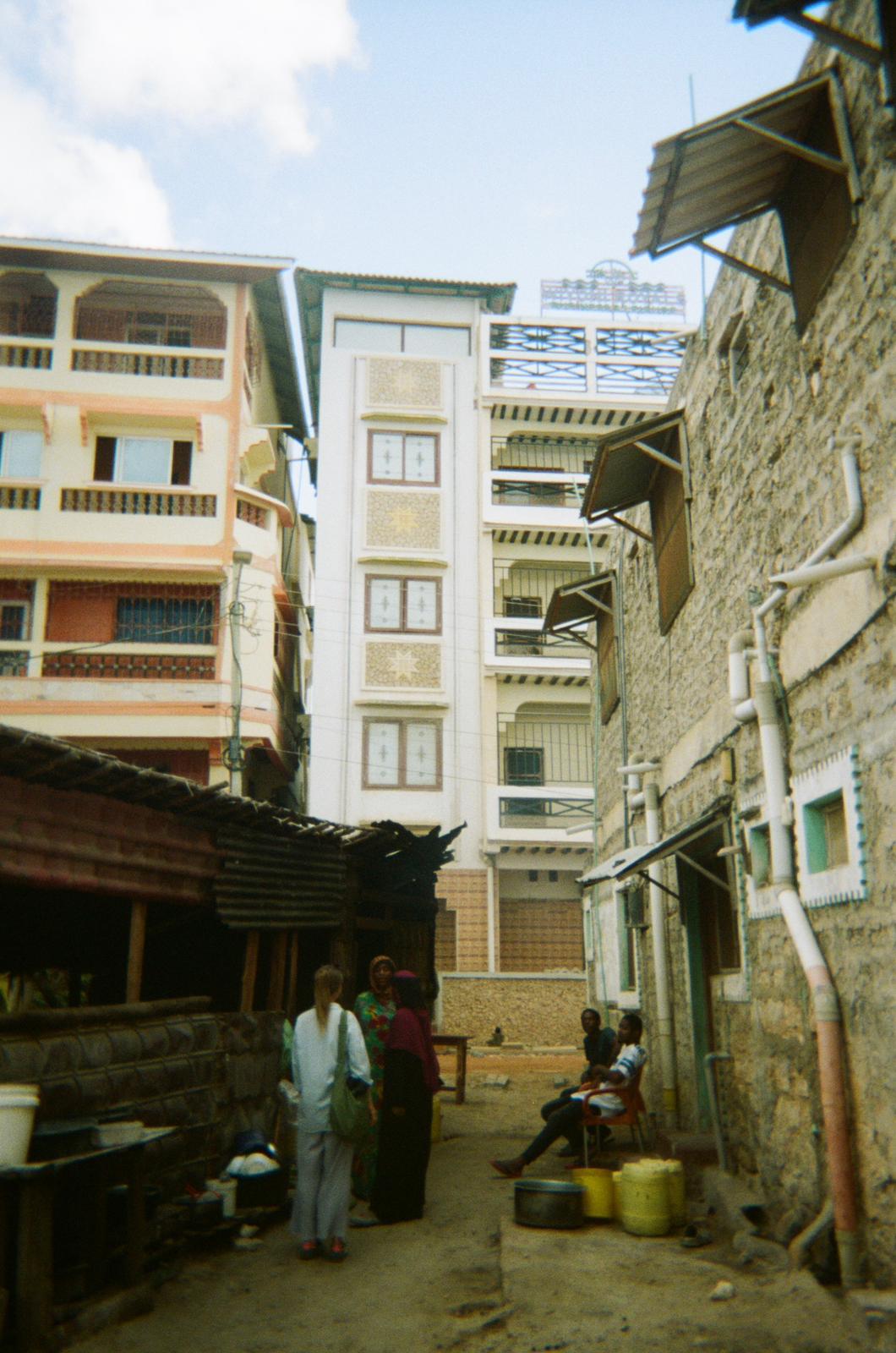
Members of the research team interviewing a local business owner in Wiyoni
That was the starting point of my seminar paper. Not a grand revelation, but a persistent discomfort perceived and observed. Something that repeated itself and resurfaced. I began to realize that everyday decisions, which I call performances, inspired by Sarah Hillewaert, such as what to wear or which route to take to a neighborhood, were not made solely on an individual basis, but also as deliberate actions in relation to others’ gazes, public opinion, and unspoken rules.
Reflecting on the daily experiences of the women in our research group, most of whom are originally from the island, and the impact of these dynamics on their lives, I shifted my focus to understand how such issues affect migrant women. In this context, Wiyoni proved to be a key place for this observation, as it is where most people from other parts of the country are concentrated on Lamu Island.
Reflecting on the daily experiences of the women in our research group, most of whom are originally from the island, and the impact of these dynamics on their lives, I shifted my focus to understand how such issues affect migrant women. In this context, Wiyoni proved to be a key place for this observation, as it is where most people from other parts of the country are concentrated on Lamu Island.
As a migrant, I recognize that moving involves profound changes in daily life and in how one envisions the future. However, my own migratory experience may differ significantly from that of the women in Wiyoni, whose motivations, circumstances, and contexts are distinct from mine. Therefore, when addressing social codes and forms of belonging in Lamu, especially in Wiyoni, it is essential to emphasize that these are specific contexts with their own dynamics that cannot be generalized to all migratory experiences. This diversity shows that the concept of “migrant” encompasses multiple realities, making it necessary to understand the specificities of each group in order to grasp the complexity of their trajectories. That said, it is possible to affirm that social codes vary everywhere, but I developed a particular curiosity about how these codes manifest in Lamu and, above all, in Wiyoni, where the senses of belonging were unfamiliar to me and had different complexities and carried different meanings.
For example, as a Brazilian living in Switzerland, I have had to adapt to certain local norms. However, most of the time, I do not feel obliged to behave “like a Swiss woman” and I believe I do not perform as such. The consequences of this, and the impact it has on my life, perhaps affect me less or matter less to me. But in Wiyoni, migrant women navigate codes that, if not followed, can compromise their support networks as well as their emotional, social, and even material security.
Of course, in any context, there are always individuals who, despite being aware of local social expectations, consciously choose not to follow them, and this is also a legitimate way of being. This is the case, for example, of the women who run the Wiyoni pub, who intentionally position themselves outside these rules, embracing the risks and possibilities that this stance entails.
For example, as a Brazilian living in Switzerland, I have had to adapt to certain local norms. However, most of the time, I do not feel obliged to behave “like a Swiss woman” and I believe I do not perform as such. The consequences of this, and the impact it has on my life, perhaps affect me less or matter less to me. But in Wiyoni, migrant women navigate codes that, if not followed, can compromise their support networks as well as their emotional, social, and even material security.
Of course, in any context, there are always individuals who, despite being aware of local social expectations, consciously choose not to follow them, and this is also a legitimate way of being. This is the case, for example, of the women who run the Wiyoni pub, who intentionally position themselves outside these rules, embracing the risks and possibilities that this stance entails.
This theme of non-belonging and adaptation to local rules came up repeatedly in our interviews with migrant women living in Wiyoni. They occupy the most sensitive and vulnerable edge of this social “chain.”
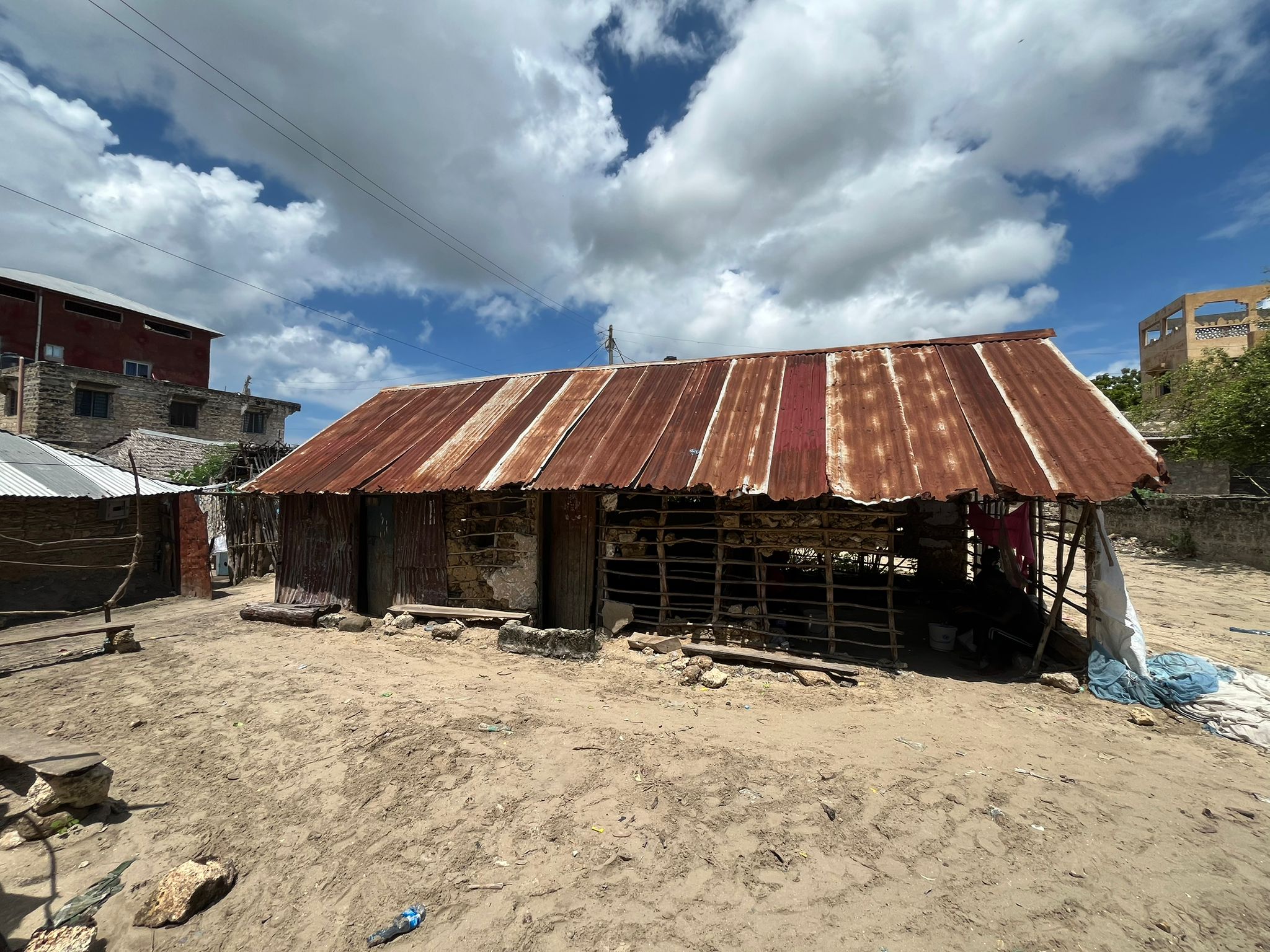
Local pub in Wiyoni
The question that has guided me since then is: how do these women (migrant, observed, scrutinized) construct a sense of belonging in a place that so often denies them legitimacy? How do they show the community whether they are (or are not) conforming to social norms?
Throughout the research, I realized that belonging in Wiyoni is constantly negotiated: never full, never guaranteed. For migrant women, this process is even more complex: beyond adapting to the material demands of life in a new place, they must also learn to navigate social codes that are often unknown or challenging.
Throughout the research, I realized that belonging in Wiyoni is constantly negotiated: never full, never guaranteed. For migrant women, this process is even more complex: beyond adapting to the material demands of life in a new place, they must also learn to navigate social codes that are often unknown or challenging.
Instead of seeking adherence to local norms (which are often exclusionary) many of them build alternative forms of belonging through horizontal alliances, informal exchanges, mutual support, and selective visibility. These practices compose a kind of social infrastructure that doesn’t appear on official maps but sustains life in Wiyoni. It is made of relationships, care, silent agreements; an everyday engineering that challenges the formal frameworks of institutional urbanism and reveals the strength of women as infrastructural agents.
At the intersection of vulnerability and agency, these women create small shifts at the boundaries of moral acceptability. Some perform respectability as expected; others publicly push against those limits and invent new ways of being. These performances (at times strategic, at others spontaneous) are not merely individual, but collective and situated. They draw a different moral cartography, in which belonging is not granted, but claimed.
By observing these dynamics, I came to understand that urban life in Wiyoni cannot be read solely through material infrastructures or official plans. It unfolds in the rhythms of everyday life, in the silences of interviews, in moments of self-censorship and rupture. It is in that space, between the visible and the invisible, that the city is made. And it is there that migrant women, with all their ambivalence, courage, and performance, sustain urban life.
Women, Migration
and Everyday in Wiyoni #2504
Infrastructural Assemblages in Wiyoni
The first connection one commonly makes with “infrastructure” is often physical, as the urbanist AbdouMaliq Simone describes (2004: 407). The physicality of infrastructure should also be understood in terms of that which is built by humans. This category then includes things such as roads, electricity networks, or ports. Field research in the neighbourhood of Wiyoni started from this point: inspired by the Kenya Informal Settlements Improvement Project (KISIP), I started to analyse the physical infrastructure of Wiyoni. KISIP plans to improve roads, street lights, and the sewage system in Wiyoni, as local interlocutors explained. However, being in the field and talking to the people who live in Wiyoni, we quickly realised that “infrastructure” consists of many more layers than these visible, physical objects. There are different social relations that are not visible at first sight, especially not as an outsider like the students from Unibas who don’t know about the cultural dynamics of the place.
From there on, I started looking out for “social” infrastructures during the field research. Social infrastructure includes relations people have with their neighbours, family and friends, and strangers, on an individual scale, as well as relations on the scale of the neighbourhood, the community elders (representatives of the neighbourhood), and towards the municipality, county government, or KISIP representatives.
Often, “physical” and “social” infrastructure are understood as separate from each other. This project critically reflects on this dichotomy and argues that they are indeed connected and influence each other. The many layers that “infrastructure” consists of form the place of Wiyoni and the daily lives of the residents. The project aims to shed light on this assemblage of different types of infrastructures, on understanding the making of Wiyoni, and to think of infrastructure as more than a human-built object.
Often, “physical” and “social” infrastructure are understood as separate from each other. This project critically reflects on this dichotomy and argues that they are indeed connected and influence each other. The many layers that “infrastructure” consists of form the place of Wiyoni and the daily lives of the residents. The project aims to shed light on this assemblage of different types of infrastructures, on understanding the making of Wiyoni, and to think of infrastructure as more than a human-built object.
Promises of Infrastructure

Street light built through KISIP
How physical and social infrastructure is connected and influenced is visible in the example of the KISIP project. One wish from the Wiyoni community, as well as the initial plan of KISIP, was to improve the neighborhood’s street lights.
They built one tall street light in the center, about 15 meters high, consisting of nine light bulbs. In that sense, the physical infrastructure was built and a promise kept. However, the light is not addressing the needs of the people, as it only lights up one small part of the neighbourhood. The physical infrastructure has an influence on how people move after dark, and further influences social ties, such as when and where to meet.
One request by the community that has not yet been addressed by officials is a market. People in Lamu usually buy fresh food (vegetables, fruits, meat, fish), usually at the market, which is located in the Old Town. The market is also a place of social interaction. Many women we talked to in Wiyoni expressed their desire for a market in Wiyoni in order to not have to go to the Old Town to buy the food. This is another example of a physical infrastructure that is tied to social interactions, as the market would not just provide people with food but also foster social relations as a place of gathering and simplify daily life by having easier access to products. Furthermore, it would allow more people in Wiyoni to have a business that could contribute to one’s income.
One request by the community that has not yet been addressed by officials is a market. People in Lamu usually buy fresh food (vegetables, fruits, meat, fish), usually at the market, which is located in the Old Town. The market is also a place of social interaction. Many women we talked to in Wiyoni expressed their desire for a market in Wiyoni in order to not have to go to the Old Town to buy the food. This is another example of a physical infrastructure that is tied to social interactions, as the market would not just provide people with food but also foster social relations as a place of gathering and simplify daily life by having easier access to products. Furthermore, it would allow more people in Wiyoni to have a business that could contribute to one’s income.
Social Ties
In our field research we mainly talked to women, as they were the focus of our research theme. Women doing business is another form of social infrastructure: First of all, women need customers to sell their products (such as baked snacks and sweets). If they know many people in the neighbourhood, it is easier to sell. Additionally, if they are well-connected to other women, they have easier access to the merry-go-round.
This is a collective fund in which women regularly pay a small amount of money. One after the other, each then receives a certain amount of money from the fund to invest in her business. This in turn contributes to the physical facilities of the neighbourhood, if a woman, for example, enlarges her store.
Time and Nature
A large part of Wiyoni consists of reclaimed land. In the 1990s, sand was extracted from the canal between Lamu Island and the mainland to enlarge the canal. Sand was put over the mangrove forest. Many buildings in Wiyoni are built on this land. The soil is eroding, which causes challenges for the building of houses and especially for sewage and water systems. These challenges further influence the daily lives of the residents, some of whom expressed their wish for improved access to water and sewage systems. Infrastructures are thus tied to the environment and, even though human-built, not separated from nature. Drawing on the work of geographer Andrew Barry (2016), the earth and soil is the infrastructure that physical, human-made infrastructure is constructed on.
Furthermore, the dimension of time shows, on the one hand, the transience of infrastructure, as nature (i.e. eroding soil) or material infrastructure can be demolished over time. On the other hand, it sheds light on how infrastructure is always in progress. Wiyoni is home to a variety of houses: at times painted buildings, at times only basic walls and a door.
Infrastructure is incomplete in the sense that it is an ongoing process: building new objects, negotiating projects and needs, getting to know new people and, perhaps, letting go of others.

Wiyoni from Above: Buildings located on reclaimed land in different stages of construction.
Uncovering Wiyoni’s Infrastructures
